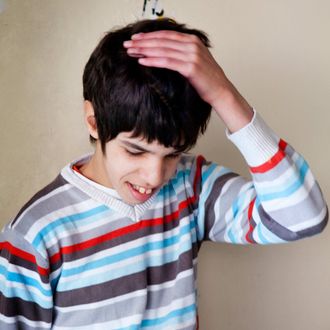
It can be hard for any parent or caretaker of a child to understand what that child’s inner world feels like, but that problem is greatly compounded when the kid in question has autism spectrum disorder. Kids with ASD can, depending on the severity of their condition, face hindered verbal communication abilities, painful sensory experiences that can (for example) make clothing feel like sandpaper, or both. In the worst cases, this can all lead to really difficult behavioral issues that are a mystery to all involved.
Writing in a new paper in the journal Autism (hat tip to Science of Us contributor Christian Jarrett at BPS Research Digest), a team of researchers led by Anne V. Kirby note that despite all this, there hasn’t been much interest in simply asking kids with ASD — or those with developed enough communication skills, at least — what they go through as they perceive the world. It’s partly the result of the belief that kids and people with disabilities — let alone people who fall in both camps — can’t offer trustworthy information about their own experiences, they write.
Kirby and her colleagues were convinced that there’d be some value in interviewing kids with ASD. So they found a dozen of them who seemed to be good candidates for interviews and engaged in semi-scripted interviews in their homes. The researchers write that “Overall, the children seemed more comfortable speaking about specific instances rather than trying to generalize their experiences.” And this comes through in the excerpts they selected to include in their study — one gets a better sense of these kids’ inner lives from reading about what bothers them (or doesn’t bother them), as compared to their attempts to draw broader conclusions.
For instance:
Interviewer]: Well, let’s talk about the blender. You said that was a bad sound. Tell me a little bit about that.
[Child]: Well, it’s really, it’s just really loud, and the noise just, um, is horrible.
I: Oh, how does it make your ears feel?
C: Bad, and so I just have to cover them. [Demonstrates] One time, when I was at a theater camp, where the director reads a story and, and I’d be dressed up in costumes of the characters in the story and get to play them, and I played as many things. I played, I been, and one time, one
director, she was a very old woman, was playing a vacuum. I just covered my ears.
Or another one of the interviewees, highlighting the discomfort they face as a result of stimuli that most of us would barely notice:
I: Is there anything else that hurts your ears?
C: Um (pause) Um, I think that’s it.
I: What can you do to
C: [interrupting] I mean no, sometimes those scoreboards uh, when uh, when it sounds and it goes “Brrrrrrrr” and it’s louder, it’s louder than my mouth.
A child with a similar aversion to these sounds described their inner monologue (it might actually be the same kid, but it’s not clear from the paper):
And I heard the buzzer and I started to have panic, like, “Ahh!,” like the panic that my brain is going in, like “what should I do, what should I do? Ahh!” It’s kind of like bouncing off the walls in, um, my head, like “what should I do?”
It can be extremely challenging to understand these children’s worlds, of course — a challenge that’s painfully familiar to many parents of kids with autism. Kirby and her colleagues’ suggestion — let the kids describe what they’re going through! — shouldn’t be a radical one, but it is.




